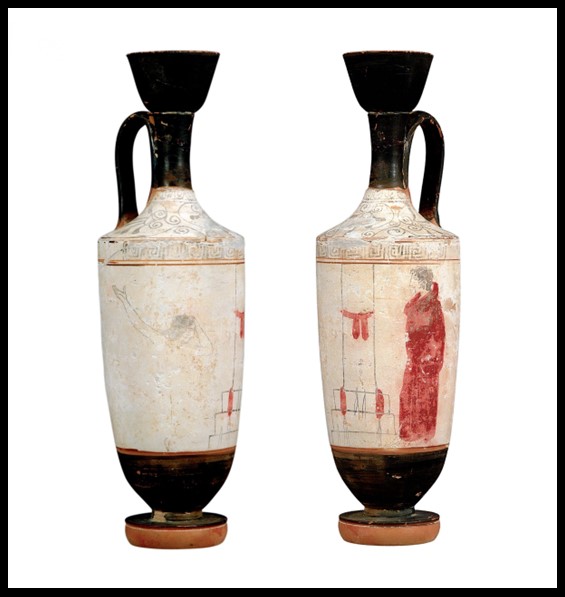
Intended as a grave gift, this beautiful, white-ground Lekythos in the Canellopoulos Museum is a distinctive 5th century type of Athenian vessel. According to Maria S. Brouscari… the composition presented on the pot’s body, features, a tall, narrow stele with three steps, decorated with fillets, one at the top of the stele and one with its ends hanging over the top step, from which hang also two thin cords. To the left of the stele, a kneeling woman mourns. With her left hand she strikes her head, while her right is outstretched in a gesture of despair. To the right of the stele the dead stands motionless: a young man, fully clad in a deep purple garment, leaving only the head uncovered. His hair is rendered with a dilute black paint. The decoration of the Canellopoulos Museum Lekythos is typical of scenes connected with funerary rituals and can give us some insight into ancient Athenian funerary practices and ideas about death. https://camu.gr/en/item/likythos/
The Athenian, white-ground Lekythos, developed during the Classical period (5th-4th centuries BC), when Athenian potters began to cover the natural reddish color of their pottery with clay that turned white when fired. These small in size oil containers were used in funerary rituals in a number of different ways. They were, for example, burned with the body in cremations, used for pouring oil libations on the body or the grave site, and as offerings, were left at or in a burial. The great majority of these vessels have been found in and around graves, in Attica. https://www.getty.edu/art/collection/object/103VMY
When I look at the Lekythos in the Canellopoulos Museum, I think of Simonides of Ceos. His poetry, widely admired for its beauty, precision, and emotional depth, befits the funerary composition of the white-ground Lekythos in the Athenian Museum…
Fragment 520: ἀνθρώπων ὀλίγον μὲν / κάρτος, ἄπρακτοι δὲ μεληδόνες, / αἰῶνι δ᾽ ἐν παύρωι πόνος ἀμφὶ πόνωι· / ὁ δ᾽ ἄφυκτος ὁμῶς ἐπικρέμαται θάνατος· / είνου γὰρ ἴσον λάχον μέρος οἵ τ᾽ ἀγαθοὶ / ὅστις τε κακός. – Των ανθρώπων λιγοστή η δύναμη κι άκαρπο ό,τι φροντίζουν πιο πολύ· στη σύντομη ζωή τους η μια στεναχώρια ακολουθεί την άλλη. Αναπόδραστος ο θάνατος ζυγιάζεται από πάνω τους χωρίς διάκριση· ευγενείς και ταπεινοί, όλοι έχουν μπροστά τους την ίδια μοίρα. (Translated by I. N. Kazazis) – Little is the strength of men and fruitless what they care most for; in their short life one sorrow follows another. Death, inescapable, weighs upon them without distinction; noble and humble, all face the same fate. https://www.greek-lan guage.gr/digitalResources/ancient_greek/anthology/poetry/browse.html?text_id=431
Fragment 521: ἄνθρωπος ἐὼν μή ποτε φάσηις ὅ τι γίνεται αὔριον, / μηδ᾽ ἄνδρα ἰδὼν ὄλβιον ὅσσον χρόνον ἔσσεται· / ὠκεῖα γὰρ οὐδὲ τανυπτερύγου μυίας / οὕτως ἁ μετάστασις. – Είσαι άνθρωπος, και γι᾽ αυτό ποτέ μην πεις τί μέλλει αύριο να συμβεί, μήτε να προβλέψεις, σαν δεις κανέναν να ευτυχεί, πόσον καιρό θα κρατήσει αυτό. Γιατί τόσο γοργό σαν την αλλαγή της μοίρας δεν είναι ούτε το φτερούγισμα της μακρόφτερης μύγας. (Translated by I. N. Kazazis) – You are only human, so, never tell what will happen tomorrow, do not predict, if you see someone happy, how long his happiness will last. Because fate changes faster and swifter than the fluttering of the long-flying fly. https://www.greek-language.gr/digitalResources/ancient_greek/anthology/poetry/browse.html?text_id=432
Fragment 522: πάντα γὰρ μίαν ἱκνεῖται δασπλῆτα Χάρυβδιν, αἱ μεγάλαι τ᾽ ἀρεταὶ καὶ ὁ πλοῦτος. – Γιατί όλα τα πράγματα καταλήγουν στην ίδια φριχτή Χάρυβδη, κι οι μεγάλες επιτυχίες και ο πλούτος. (Translated by I. N. Kazazis) – For all things come down to the same horrible Charybdis; people’s virtues and success. https://www.greek-language.gr/digitalResources/ancient_greek/anthology/poetry/browse.html?text_id=433
For a Student Activity, please… Check HERE!